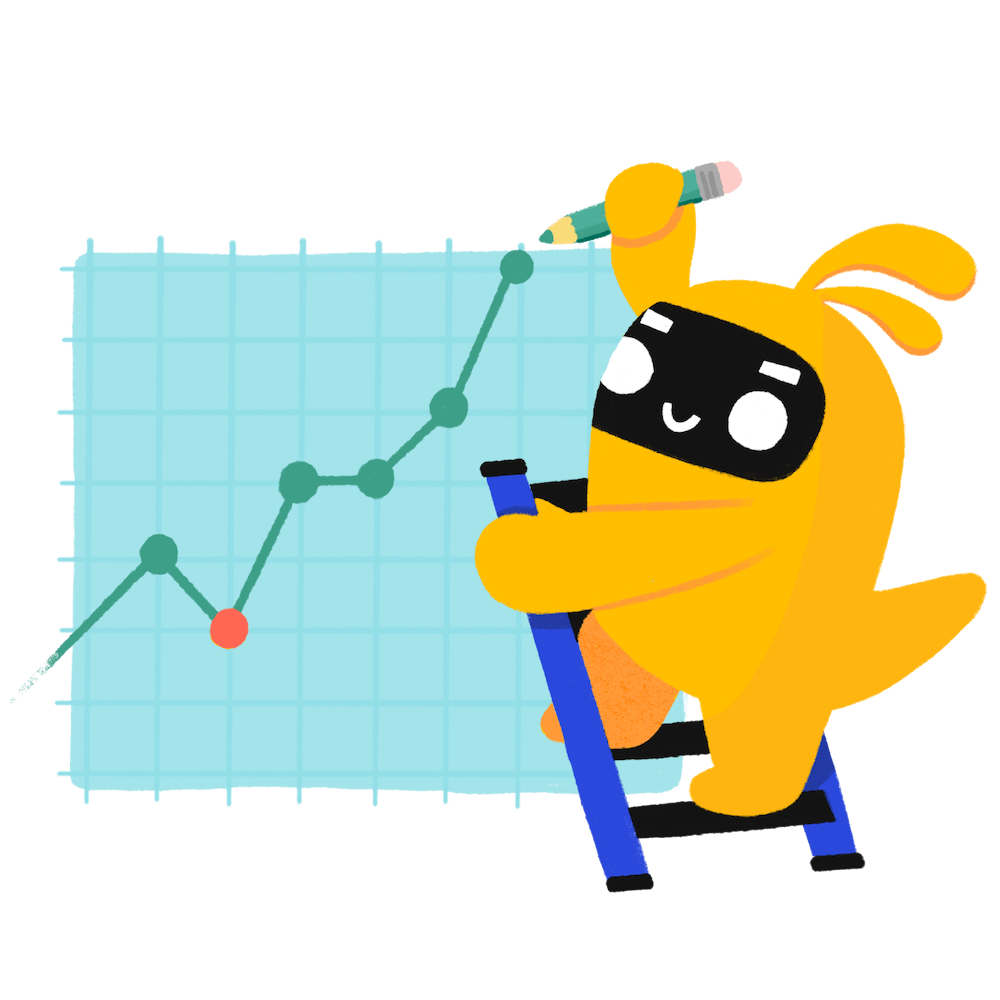5 customisable OKR examples for Peer Review Team
What are Peer Review Team OKRs?
The Objective and Key Results (OKR) framework is a simple goal-setting methodology that was introduced at Intel by Andy Grove in the 70s. It became popular after John Doerr introduced it to Google in the 90s, and it's now used by teams of all sizes to set and track ambitious goals at scale.
Crafting effective OKRs can be challenging, particularly for beginners. Emphasizing outcomes rather than projects should be the core of your planning.
We have a collection of OKRs examples for Peer Review Team to give you some inspiration. You can use any of the templates below as a starting point for your OKRs.
If you want to learn more about the framework, you can read our OKR guide online.
Building your own Peer Review Team OKRs with AI
While we have some examples available, it's likely that you'll have specific scenarios that aren't covered here. You can use our free AI generator below or our more complete goal-setting system to generate your own OKRs.
Feel free to explore our tools:
- Use our free OKR generator
- Use Tability, a complete platform to set and track OKRs and initiatives, including a GPT-4 powered goal generator
Our customisable Peer Review Team OKRs examples
You will find in the next section many different Peer Review Team Objectives and Key Results. We've included strategic initiatives in our templates to give you a better idea of the different between the key results (how we measure progress), and the initiatives (what we do to achieve the results).
Hope you'll find this helpful!
1. OKRs to enhance knowledge and understanding through qualitative research
Enhance knowledge and understanding through qualitative research
Review and analyze 10 relevant scholarly articles per week
Systematically read and make notes on each article
Analyze each article's content, context, and conclusions
Select 10 scholarly articles related to the research topic
Conduct 3 interviews with industry experts
Identify and reach out to three industry experts for interviews
Prepare comprehensive interview questions relevant to their expertise
Schedule and conduct the three interviews
Submit one comprehensive research report for peer review
Conduct thorough research on chosen topic
Write comprehensive report incorporating research
Submit report for peer review
2. OKRs to enhance skill at describing campus locations
Enhance skill at describing campus locations
Get feedback on descriptions from 3 different peers for improvement
Analyze received feedback for possible improvements
Send descriptions to selected peers for feedback
Identify 3 peers to review your descriptions
Achieve a 90% satisfactory rating on descriptive composition focused on campus locations
Regularly practice writing descriptive compositions
Thoroughly study descriptions of various campus locations
Request and incorporate feedback from peers
Practice detailed description of 5 different campus places every week
Choose 5 unique campus locations to explore each week
Review and revise your descriptions regularly for improvement
Write a detailed description for each chosen location
3. OKRs to improve the quality and relevancy of content through comprehensive revisions
Improve the quality and relevancy of content through comprehensive revisions
Raise positive reader feedback on revised content by 25%
Include a call-to-action encouraging readers to leave feedback
Enhance content quality through professional proofreading and editing
Implement surveys to collect readers' opinions on revisions
Increase peer reviews per article by 30% to ensure thorough evaluation
Improve training for potential reviewers
Develop and implement a new, incentivized peer-review policy
Mandate additional reviews during article submission procedure
Reduce average article revision time by 20% without compromising quality
Utilize article review templates to streamline process
Implement time-management training for article review team
Automate revising process using language editing software
4. OKRs to effectively generate quality data flow diagrams
Effectively generate quality data flow diagrams
Ensure no errors in final design of at least 8 diagrams validated by team
Assign team to thoroughly review each of the 8 diagrams
Obtain team's approval on updated design of diagrams
Implement team's feedback and corrections into final designs
Create and complete 10 unique data flow diagrams by end of quarter
Review and finalize each diagram
Identify necessary components for each data flow diagram
Draft 10 unique data flow diagrams
Incorporate feedback from peers on first 5 diagrams to improve following 5
Review feedback from peers on initial diagrams
Implement feedback into subsequent five diagrams
Identify necessary improvements for next diagrams
5. OKRs to increase mastery in applying the agile process
Increase mastery in applying the agile process
Facilitate a peer-review session around agile processes, receiving an average feedback score of 4/5
Distribute a feedback form to assess the session
Conduct an engaging and informative agile process review
Prepare a comprehensive agenda for the peer-review session
Implement three improvements from learned agile techniques in current projects
Apply agile principles into daily routines and decision-making process
Implement a sprints-based timeline for project tasks
Incorporate regular stand-up meetings into project framework
Complete two online agile process management courses with a score of 90% or above
Allocate time daily to learn and review course materials
Complete all course quizzes and assignments, targeting a 90%+ score
Research and enroll in two online Agile process management courses
Peer Review Team OKR best practices to boost success
Generally speaking, your objectives should be ambitious yet achievable, and your key results should be measurable and time-bound (using the SMART framework can be helpful). It is also recommended to list strategic initiatives under your key results, as it'll help you avoid the common mistake of listing projects in your KRs.
Here are a couple of best practices extracted from our OKR implementation guide 👇
Tip #1: Limit the number of key results
The #1 role of OKRs is to help you and your team focus on what really matters. Business-as-usual activities will still be happening, but you do not need to track your entire roadmap in the OKRs.
We recommend having 3-4 objectives, and 3-4 key results per objective. A platform like Tability can run audits on your data to help you identify the plans that have too many goals.
 Tability's audit dashboard will highlight opportunities to improve OKRs
Tability's audit dashboard will highlight opportunities to improve OKRsTip #2: Commit to weekly OKR check-ins
Don't fall into the set-and-forget trap. It is important to adopt a weekly check-in process to get the full value of your OKRs and make your strategy agile – otherwise this is nothing more than a reporting exercise.
Being able to see trends for your key results will also keep yourself honest.
 Tability's check-ins will save you hours and increase transparency
Tability's check-ins will save you hours and increase transparencyTip #3: No more than 2 yellow statuses in a row
Yes, this is another tip for goal-tracking instead of goal-setting (but you'll get plenty of OKR examples above). But, once you have your goals defined, it will be your ability to keep the right sense of urgency that will make the difference.
As a rule of thumb, it's best to avoid having more than 2 yellow/at risk statuses in a row.
Make a call on the 3rd update. You should be either back on track, or off track. This sounds harsh but it's the best way to signal risks early enough to fix things.
How to turn your Peer Review Team OKRs in a strategy map
The rules of OKRs are simple. Quarterly OKRs should be tracked weekly, and yearly OKRs should be tracked monthly. Reviewing progress periodically has several advantages:
- It brings the goals back to the top of the mind
- It will highlight poorly set OKRs
- It will surface execution risks
- It improves transparency and accountability
Spreadsheets are enough to get started. Then, once you need to scale you can use a proper OKR platform to make things easier.
 Tability's Strategy Map makes it easy to see all your org's OKRs
Tability's Strategy Map makes it easy to see all your org's OKRsIf you're not yet set on a tool, you can check out the 5 best OKR tracking templates guide to find the best way to monitor progress during the quarter.
More Peer Review Team OKR templates
We have more templates to help you draft your team goals and OKRs.
OKRs to enhance app performance for a smoother user experience
OKRs to establish robust connections to the Database via Pgadmin
OKRs to foster an inclusive, equitable, and diverse office culture
OKRs to ensure complete quality documentation for all factory hardware
OKRs to achieve production readiness for MassBalancer ISCC EU feature
OKRs to implement system automation for enhanced efficiency
OKRs resources
Here are a list of resources to help you adopt the Objectives and Key Results framework.
- To learn: What is the meaning of OKRs
- Blog posts: ODT Blog
- Success metrics: KPIs examples
Create more examples in our app
You can use Tability to create OKRs with AI – and keep yourself accountable 👀
Tability is a unique goal-tracking platform built to save hours at work and help teams stay on top of their goals.
 1 Create your workspace
1 Create your workspace 2 Build plans in seconds with AI
2 Build plans in seconds with AI 3Track your progress
3Track your progress